
Dresden is the capital city of the German state of Saxony and its second most populous city after Leipzig. It is the 12th most populous city of Germany, the fourth largest by area, and the third most populous city in the area of former East Germany, after Berlin and Leipzig. Dresden's urban area comprises the towns of Freital, Pirna, Radebeul, Meissen, Coswig, Radeberg and Heidenau and has around 790,000 inhabitants. The Dresden metropolitan area has approximately 1.34 million inhabitants.
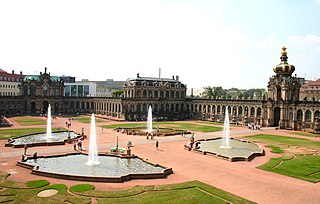
The Zwinger is a palatial complex with gardens in Dresden, Germany. Designed by architect Matthäus Daniel Pöppelmann, it is one of the most important buildings of the Baroque period in Germany. Along with the Frauenkirche, the Zwinger is the most famous architectural monument of Dresden.

Augustus II the Strong, was Elector of Saxony from 1694 as well as King of Poland and Grand Duke of Lithuania from 1697 to 1706 and from 1709 until his death in 1733. He belonged to the Albertine branch of the House of Wettin.
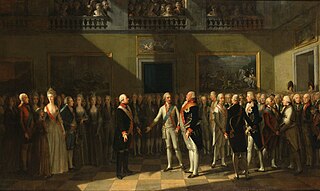
The Declaration of Pillnitz was a statement of five sentences issued on 27 August 1791 at Pillnitz Castle near Dresden (Saxony) by Frederick William II of Prussia and the Habsburg Leopold II, Holy Roman Emperor who was Marie Antoinette's brother. It declared the joint support of the Holy Roman Empire and of Prussia for King Louis XVI of France against the French Revolution.

Malá Strana or more formally Menší Město pražské is a district of the city of Prague, Czech Republic, and one of its most historic neighbourhoods.

Loschwitz is a borough (Stadtbezirk) of Dresden, Germany, incorporated in 1921. It consists of ten quarters (Stadtteile):

Matthäus Daniel Pöppelmann (1662–1736) was a German master builder and architect who helped to rebuild Dresden after the fire of 1685. His most famous work is the Zwinger Palace.

The Schleißheim Palace comprises three individual palaces in a grand Baroque park in the village of Oberschleißheim, a suburb of Munich, Bavaria, Germany. The palace was a summer residence of the Bavarian rulers of the House of Wittelsbach.
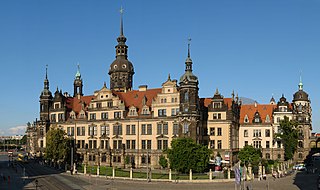
Dresden Castle or Royal Palace is one of the oldest buildings in Dresden, Germany. For almost 400 years, it was the residence of the electors (1547–1806) and kings (1806–1918) of Saxony from the Albertine House of Wettin as well as Kings of Poland (1697–1763). It is known for the different architectural styles employed, from Baroque to Neo-renaissance.

Staatliche Kunstsammlungen Dresden is a cultural institution in Dresden, Germany, owned by the State of Saxony. It is one of the most renowned and oldest museum institutions in the world, originating from the collections of the Saxon electors in the 16th century.
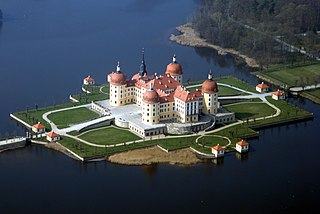
Moritzburg Castle or Moritzburg Palace is a Baroque palace in Moritzburg, in the German state of Saxony, about 13 kilometres (8.1 mi) northwest of the Saxon capital, Dresden. The castle has four round towers and lies on a symmetrical artificial island. It is named after Duke Moritz of Saxony, who had a hunting lodge built there between 1542 and 1546. The surrounding woodlands and lakes were a favourite hunting area of the electors and kings of Saxony.

The architecture of Germany has a long, rich and diverse history. Every major European style from Roman to Postmodern is represented, including renowned examples of Carolingian, Romanesque, Gothic, Renaissance, Baroque, Classical, Modern and International Style architecture.

Schloss, formerly written Schloß, is the German term for a building similar to a château, palace, or manor house.

Pillnitz Palace is a restored Baroque castle at the eastern end of the city of Dresden in the German state of Saxony. It is located on the right bank of the River Elbe in the former village of Pillnitz. It was the summer residence of many electors and kings of Saxony; it is also known for the Declaration of Pillnitz in 1791.
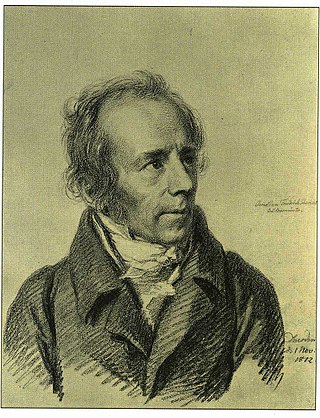
Christian Friedrich Schuricht was a German architect and painter who designed, among others, the New Palace and the Chinese garden at Pillnitz Castle.
Zacharias Longuelune was a French architect and master builder who worked in the second half of his life for the royal court in Dresden. His design style was French Baroque and Classicism.

The State Palaces, Castles and Gardens of Saxony is a state-owned company with its head office in Dresden. It belongs to the Saxon State Ministry of Finance and has the aim of preserving Saxon cultural heritage whilst respecting cultural and conservation needs. The state-owned company manages several palaces, castles and parks in the Saxony. These include the Zwinger in Dresden, the Albrechtsburg in Meissen and Kriebstein Castle.

The Baroque garden was a style of garden based upon symmetry and the principle of imposing order on nature. The style originated in the late-16th century in Italy, in the gardens of the Vatican and the Villa Borghese gardens in Rome and in the gardens of the Villa d'Este in Tivoli, and then spread to France, where it became known as the jardin à la française or French formal garden. The grandest example is found in the Gardens of Versailles designed during the 17th century by the landscape architect André Le Nôtre for Louis XIV. In the 18th century, in imitation of Versailles, very ornate Baroque gardens were built in other parts of Europe, including Germany, Austria, Spain, and in Saint-Petersburg, Russia. In the mid-18th century the style was replaced by the less geometric and more natural English landscape garden.
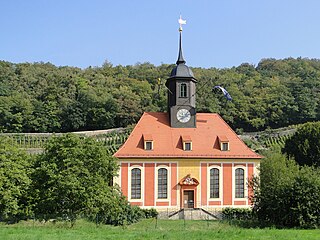
The Protestant Vineyard Church "Zum Heiligen Geist" is a baroque village church in the Dresden district of Pillnitz, named after its location in the Royal Vineyard. It is not to be confused with the Vineyard Church built in the 20th century in the Trachenberge district of Dresden.
























